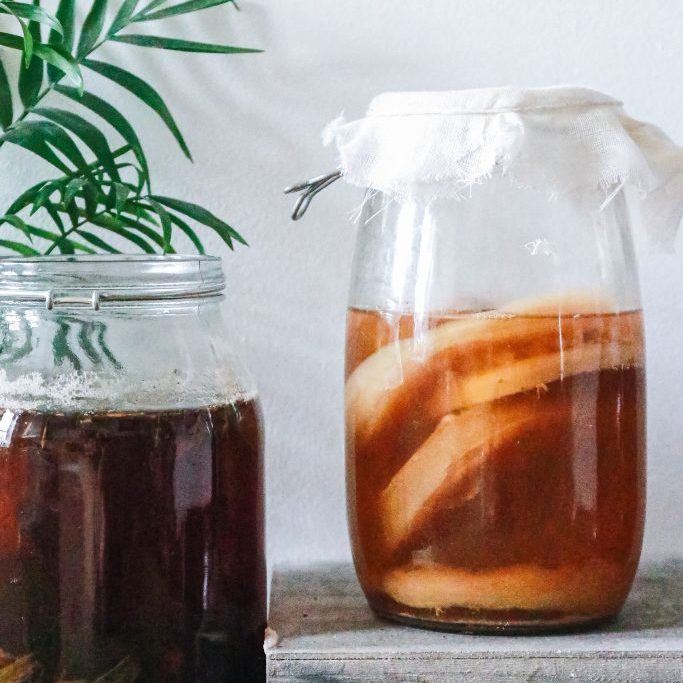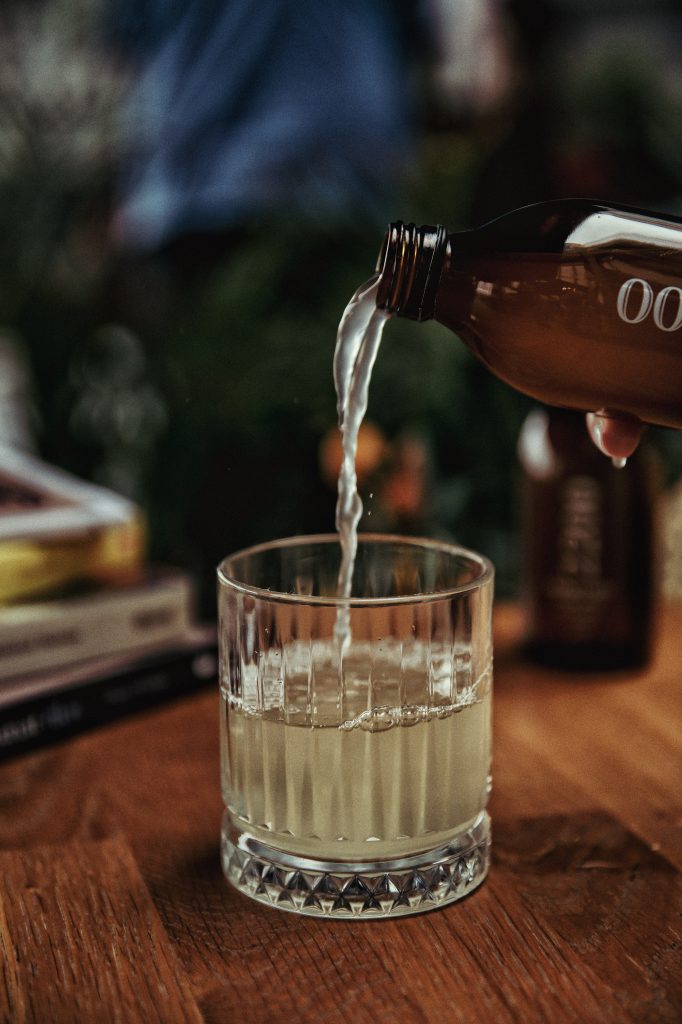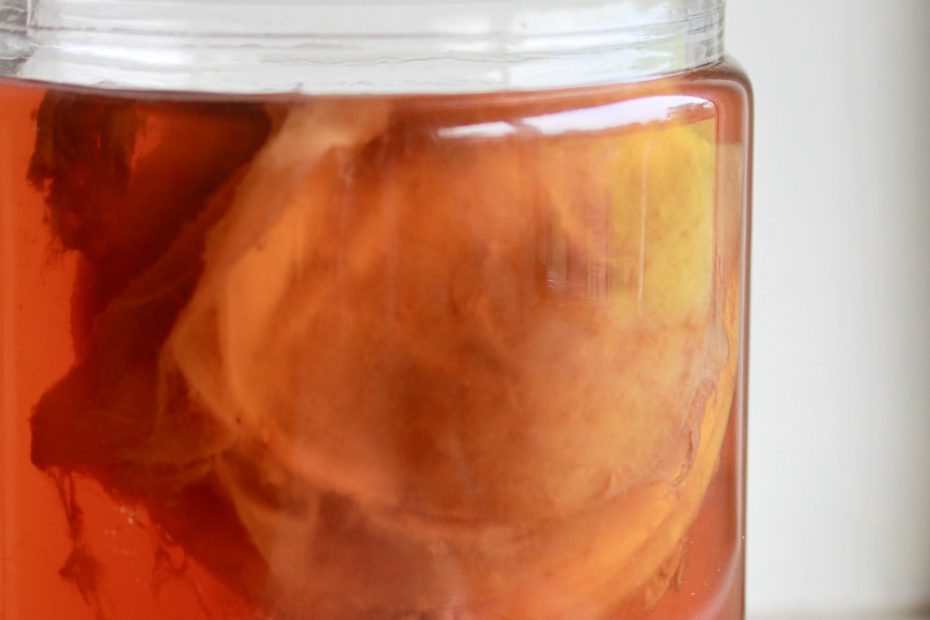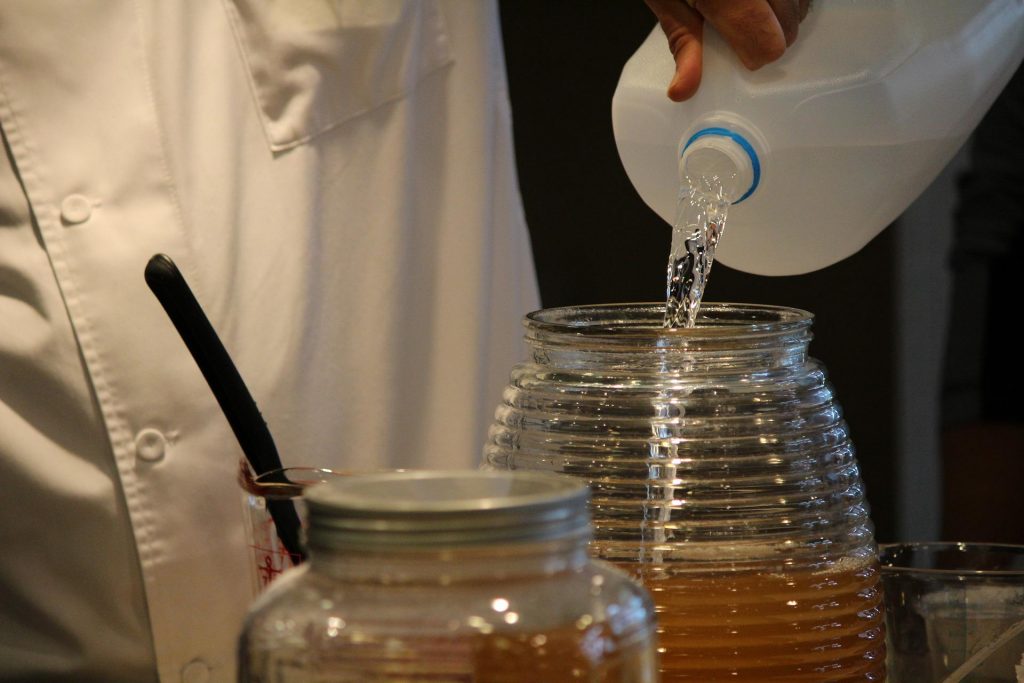Kombucha: What It Is, Benefits And How To Prepare It
Kombucha is a fermented beverage that is a relative of beer, wine, kvass and tepache – but also of many other fermented foods such as yogurt, water kefir, kimchi, sauerkraut and fermented vegetables – rich in beneficial properties for our bodies. Kombucha is a significant food full of “friendly” microorganisms, antioxidants, flavonoids, and B vitamins. Additionally, it works wonders for liver and blood purification and is good for boosting the immune system.
The preparation of Kombucha involves fermenting sweetened tea with a special culture of yeasts and bacteria named SCOBY, and from its prolonged fermentation Kombucha vinegar is obtained.
This fermented tea drink has a very long tradition behind it, in fact it has been drunk for over two thousand years in the East, and today it has also become famous in the West as it is very rich in benefits and properties, becoming a much sought-after beverage in many nations.
Kombucha is now widespread in the United States and is slowly making its way into Europe as well (England first and foremost).
What is Kombucha?
Our mini-guide starts off with defining Kombucha. By fermenting sweetened tea using SCOBY, a unique culture of friendly bacteria and yeasts, we can create a tea-based “living beverage” that is mildly effervescent, low in sugar, and rich in healthy characteristics. It is counted among the foods allied to our bodies as a functional beverage precisely because of its many benefits. A beverage with similar properties is Jun Tea, made through the fermentation of green tea and honey, which is why it is also known as the “Champagne of Kombucha.”
In actuality, kombucha is full with bacteria that can help to maintain the health of our gut flora. It is also antibacterial, antioxidant, energetic, cleansing, and some people even say it elevates mood. But be careful not to mistake it for Konbucha. Many people mistakenly think that kombucha is the same thing as konbucha, which is actually a type of seaweed called konbu that is frequently used to create tea or in cooking. It is also termed in a variety of other ways, most of which are incorrect. In fact, the terms “kambucha,” “kombucha mushroom,” and “tea mushroom” are frequently used improperly.
Fermented Tea-Based Beverage Called Elixir Of Long Life
Also known as Kombucha Tea or Fermented Tea, Kombucha is a type of fermented tea that can be made with any sweetened tea, including green tea, black tea, white tea, mate, and coffee. It is made using a SCOBY, or symbiotic culture of yeast and bacteria, which stands for Symbiotic Culture of Bacteria and Yeast.
Similar to how they do it with beer and wine, the yeasts in the SCOBY break down the sugar added to the tea to create carbon dioxide and alcohol, usually in amounts less than 1%. Why are fermented foods and beverages usually recognized for their health benefits? Since the beginning of time, there has been life on Earth. The environment in which humans live uses the fermentation process to “digest” or reduce complex organic materials to single molecules.
We only need to consider the millions of microorganisms that perform the arduous task of digestion for us by converting complex chemical bonds between molecules into simple bonds and releasing vitamins, minerals, and other nutrients to understand how fermented foods and beverages, such as Kombucha, benefit our bodies.
What Does Kombucha Taste Like?
One of the aspects that most intrigues people approaching this world is certainly the taste of kombucha. An important premise to make is that although it is a fermented tea, it does not taste like tea, or at least it is not the predominant flavor.
We always like to look back at the meme of the girl trying kombucha for the first time and think about the expressions our friends and customers make…she beats everyone though!
Kombucha tastes crisp, slightly acidic, but never unpleasant. In the not-too-flavored variants it is reminiscent of apple cider, to some even prosecco and champagne.
The flavor of Kombucha changes greatly depending on the days of fermentation, the type of tea used, and the flavorings. It is normally a pleasant-tasting, refreshing drink that is also suitable as an ingredient in alcoholic and nonalcoholic cocktails.

A Dash Of History
When one hears about Kombucha it may seem to most people that it is a new super genuine drink that appeared who knows how and who knows where. It isn’t.
Kombucha has an age-old and somewhat mysterious history composed of intertwining myths and stories that do not definitively clarify where and when the first sip was taken. We have collected some of the best-known accounts to shed some light on the history and origins of Kombucha Tea.
The story of Emperor Qin Chi Huangdi
Qin Chi Huangdi was the first emperor of unified China from 247 to 221 B.C. In his old age, Qin Chi began to be obsessed with the thought of immortality to the point that he relied on an alchemist who prepared a drink for him, named “elixir of long life”: kombucha. Qin Chi died after several years of his passion for kombucha, having ingested pills containing mercury in the hope that they would make him immortal.
The myth of Dr. Kombu and the Japanese emperor.
It is said that during the fifth century B.C., a Korean doctor named Kombu-ha-chimu-kami-ki-mu, better known as Dr. Kombu, was called upon by the Japanese emperor, who was nearing death to be healed. Dr. Kombu prepared an elixir for the emperor, who suddenly recovered. The incredible potency of Dr. Kombu’s tea-in Chinese “cha”-was thus celebrated and celebrated. Hence Kombu-Cha.
The portentous drink of the Japanese Samurai.
It is said that Kombucha was first used during the 10th century B.C. by the Japanese Samurai and that they drank it before any battle or combat since it could make them stronger and more cunning.
Scoby: The Kombucha “Mushroom”
One of the most common inaccuracies is related to the fungus in kombucha. Many people confuse SCOBY – symbiotic cultures of bacteria and yeast – with a fungus that lives in kombucha and makes it the drink that it is. Let’s make it clear once and for all, SCOBY is not a fungus, but as the acronym itself says, a culture of bacteria and yeast living symbiotically with each other.
The SCOBY-what some people insist on calling the miracle fungus in kombucha-looks like a gelatinous disc that floats on the surface of the liquid and is fed by the sugars added to the tea and the tannins that tea leaves naturally contain.
It is a collection of live micro-organisms that are the real players in the transformation of sweetened tea into Kombucha. SCOBY is therefore the most important ingredient-if it can be called that- in the preparation of Kombucha. It must be treated with care, pampered and well fed for it to grow and reproduce. When you wish to put it aside, it can also be kept in the refrigerator.
Kombucha: Benefits And Properties
By reading this mini-guide you will now be well aware that there are indeed many benefits and properties of Kombucha and that this fermented beverage is a true ally of our body. In this section of our guide we want to delve into precisely the properties and benefits of kombucha. Let’s start right away.
In a recent interview in Wired with Professor Cavalieri, professor of Microbiology at the University of Florence (Italy), it emerged how studies on this drink, although not yet very many, reveal a number of scientifically proven kombucha properties and benefits.
Kombucha’s three key characteristics are as follows:
- antioxidant, referring to the components of tea, such as polyphenols
- antibacterial, as a result of the microorganisms that defend the beverage from external infections and combat them
- antifungal
Dr. Cavalieri points out in the interview how we are certainly not talking about a drug-and this is a concept that we are also keen to highlight-but the scientific evidence is strong enough to say that its effects exist.
These properties of kombucha are also confirmed by other studies conducted in vitreous and on animals that count other benefits to this exquisite fermented tea drink.
- Aids the liver and digestive system in their everyday activities
- Strengthens the immune system
- Excellent for liver detoxification and body purification
- Inhibits the advancement of cancer cells
- Ideal against cardiovascular problems
Given the recent interest in this beverage, there haven’t been any scientific research on humans to date, but the vitreous and animal studies stated above are promising.
Other Properties
Numerous articles list additional merits of kombucha in addition to those already mentioned and supported by scientific studies.
- Fights acid reflux
- Excellent against Acne
- Natural anxiolytic
- Beneficial for those who have colitis
- Enhances mood and is advised for persons who are depressed
- Helps with deflation
- Fights hangover
- Ideal against headaches
- Good for those suffering from hypertension
- Helps with hypoglycemia for those with diabetes
- Improves digestion
- Ally of all women during premenstrual syndrome
- Helpful against rheumatism
Kombucha Contraindications And False Myths
On Kombucha’s contraindications, risks, and harmful effects there are a number of articles on the Web that cite no scientific sources and often contradict each other. Recently, for example, some have appeared about kombucha toxicity and various dangers.
We took up Dr. Cavalieri’s talk in Wired in June 2018 to dispel some myths about kombucha tea’s dangerousness and contraindications. Cavalieri says that as far as adverse effects in the scientific literature are concerned, there are only a couple of cases treated in publications in not particularly authoritative journals. In his view, “these studies are not sufficient to demonstrate a specific dangerousness, because we are talking about side effects that may have a number of concomitant causes and may not necessarily be related to kombucha consumption. … Based on what has been documented, one certainly cannot say that kombucha is dangerous, just as wine, beer or vaccines are not dangerous.”
Dr. Duccio Cavalieri, professor of microbiology at the University of Florence – Interview with Wired
Kombucha and Sugar
Many people-and among them quite well-known media outlets-argue that the amount of sugar in kombucha is too high and therefore harmful to our health. This statement is definitely inaccurate. It is true that kombucha contains sugar, but in small amounts. No more than 90% of the soft drinks you are often used to consuming.
In addition, it is possible to further lower the amount of sugar in kombucha by letting it ferment longer. During fermentation, the bacteria eat the sugar, converting it to acetic acid.
Kombucha and Alcohol
Another inaccurate statement about this beverage relates to the relationship between kombucha and alcohol. This fermented tea is in fact a nonalcoholic beverage: that is, it contains less than 1.2 percent alcohol. It is therefore a minimal amount that has no side effects on our bodies. Since kombucha has alcohol-even if only a small amount-its consumption is not recommended for pregnant women.
However, there is a variant of kombucha called hard kombucha, in which more alcohol is intentionally made to develop by further fermentation processes.
Side Effects Of Kombucha
To date there do not appear to be any side effects in kombucha. However, since it is often a home-fermented beverage, it is always a good idea to adhere to all the good hygiene and storage practices suitable for producing a product with high quality standards and above all not dangerous to our health. Just as you would for the home preparation of any recipe or food.
Kombucha Preparation And Recipe
The mini-guide on Kombucha Tea finally gets to talk about the preparation of Kombucha and the recipe for making one at home without any particular problems. We thus wanted to answer the many people who write to us with questions such as “how do you make kombucha?”, “how do you store it?” or even “how to grow kombucha.”
Kombucha brewers call kombucha production BATCH. You will find this term often from now on.
Are you ready to start brewing kombucha?
Ingredients
When preparing our kombucha, it is always important to use only high quality ingredients such as:
- Water
- Leaf tea
- Crystals of brown sugar
- Quality, live and well active SCOBYs
- Kombucha Starter – that is, kombucha from another fermentation
- Spices and botanicals for flavoring
Measuring Ingredients
For proper production of Kombucha, it is essential to measure the ingredients properly at each Batch (“production batch”).
Quantity
- 8/10 gr of tea leaves per liter of water
- 80/100 gr of sugar per liter of water
- 1 SCOBY of about 100gr per liter of water
- 50/100 ml kombucha starter per liter
- Spices, dried fruits or herbs for flavoring when needed
Let’s heat up the water
As a first step for our production we bring the water to a boil. This way we lower the bacterial load and are ready to infuse our ingredients.
Let’s Infuse the Tea
Depending on the type of kombucha we are making, the variety of tea changes. Generally, kombucha is prepared from black teas. We use black teas from Nepal, Chinese green teas, and Oolong Teas from China.
In addition to teas, we use infused spices and botanicals to flavor our kombucha. These include yerba mate, rose buds, dehydrated ginger, moringa and many other herbs and spices lend themselves perfectly to kombucha flavoring.
Each tea and ingredient has its own suitable brewing temperature in order to best extract flavor and tannins. Generally, to those who ask us how to prepare quality kombucha, we suggest following this simple scheme.
- Black tea leaves: 8 minutes infusion time
- Green tea leaves: 5 minutes infusion time
- Spices, herbs and herbal teas: 10 to 15 minutes infusion time
Most tea enthusiasts will certainly have noticed that the infusion of leaves (both green and black tea) is longer than the average infusion times of good quality leaf tea. This is to make sure that the tannins are extracted in greater quantities and help the processing into Kombucha.
We sugar the infusion
We strain the liquid by removing the tea leaves and any spices or herbs used to flavor the liquid. After that, we add brown sugar according to the predetermined amounts and stir until it dissolves completely.
The sugar will provide nourishment for the bacteria in the SCOBY and allow them to start the fermentation process that will give rise to our Kombucha. It is important to remember that the sugar will then be processed and most of it will be lost in the final result.
Let’s add The Starter
Let the resulting liquid cool until it reaches a temperature that is below 30°. We then add the appropriate amount of Kombucha starter. The starter is one of the basic ingredients for making kombucha. It is in fact a leftover from the previous batch of kombucha that will help the new production turn into kombucha tea and lower the PH of the solution by activating yeast and bacteria and in order to protect the drink from pathogenic bacteria.
It’s Time For The Scoby
The time has finally come when we soak our SCOBYs in the solution so far. The SCOBY-which stands for Symbiotic Culture Of Bacteria and Yeast-is the real star of the kombucha preparation.
As the name implies, it is a culture of bacteria and yeast that live symbiotically with each other, in perfect balance. SCOBYs are gelatinous and initiate the fermentation that will turn sweetened tea into Kombucha.
First Fermentation
Once we have covered our container with a light, breathable cotton cloth, fermentation begins, the process that makes this beverage famous and to which its many properties are due, and the first step in continued fermentation.
The fermentation process of kombucha is strongly influenced by external conditions. For example, fermentation takes place at room temperature, and the difference in temperature implies shorter or longer fermentation times.
Usually this transformation process lasts 7 to 15 days, but in summer it can even go down to only 5 days.
Bottling And Corking The Bottles
At the end of the first fermentation, when we have achieved a balanced taste, we can either remove the SCOBYs and put them to rest in SCOBY hotels, or use them immediately for a new production.
We filter the resulting kombucha and bottle it in previously sterilized bottles. We suggest using bottles with mechanical stoppers.
You can now consume it or store it in the refrigerator, or start the second fermentation.
Second Fermentation Of Kombucha
Kombucha can undergo a second fermentation by leaving the sealed bottles at room temperature for between 12 and 48 hours depending on temperatures. During this time, bacteria and yeast will feed on the sugar in the hermetically sealed bottles, consuming oxygen and producing carbon dioxide.
This will make the kombucha fizzy.
At this stage we can also add juices, extracts, chopped fruits and spices to further flavor our batch.
Having performed the second fermentation at room temperature, it is time to store our bottles in the refrigerator.
Safety First
It is super important to remember that because second fermentation generates co2, the pressure in the bottles will increase.
So be very careful! They could explode.
To be safer here are three things to do:
– use bottles with mechanical closures that allow co2 to “vent” when the pressure is excessive
– every day, at least a couple of times, open the bottle for a few seconds in order to assess the pressure inside. If you see a lot of foam, it is time to put them in the refrigerator
– for safety place a couple of rags or a tablecloth over the bottles. In case they burst they will prevent the glass pieces from splashing who knows where
Storage Of Kombucha
It is very important to know how to take care of the Kombucha even after the second fermentation is finished. We strongly advise everyone to ALWAYS store kombucha bottles in the refrigerator at a temperature between 0° and 4°.
In fact, at these temperatures the bacteria and yeasts present in kombucha are put to rest and suspend the fermentation processes. Otherwise-as kombucha is a living beverage-it would continue to transform and mutate, losing its pleasant taste and turning into a strongly acetic beverage.
We repeat: ALWAYS store bottles of kombucha in the refrigerator at a temperature between 0° and 4°.


